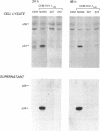Abstract
Transition state mimetic tripeptide human immunodeficiency virus (HIV) protease inhibitors containing allophenylnorstatine [(2S,3S)-3-amino-2-hydroxy-4-phenylbutyric acid] were synthesized and tested for activity against HIV in vitro. Two compounds, KNI-227 and KNI-272, which were highly potent against HIV protease with little inhibition of other aspartic proteases, showed the most potent activity against the infectivity and cytopathic effect of a wide spectrum of HIV strains. As tested in target CD4+ ATH8 cells, the 50% inhibitory concentrations of KNI-227 against HIV type 1 LAI (HIV-1LAI), HIV-1RF, HIV-1MN, and HIV-2ROD were 0.1, 0.02, 0.03, and 0.1 microM, respectively, while those of KNI-272 were 0.1, 0.02, 0.04, and 0.1 microM, respectively. Both agents completely blocked the replication of 3'-azido-2',3'-dideoxythymidine-sensitive and -insensitive clinical HIV-1 isolates at 0.08 microM as tested in target phytohemagglutinin-activated peripheral blood mononuclear cells. The ratios of 50% cytotoxic concentrations to 50% inhibitory concentrations for KNI-227 and KNI-272 were approximately 2,500 and > 4,000, respectively, as assessed in peripheral blood mononuclear cells. Both compounds blocked the posttranslational cleavage of the p55 precursor protein to generate the mature p24 Gag protein in stably HIV-1-infected cells. The n-octanol-water partition coefficients of KNI-227 and KNI-272 were high, with log Po/w values of 3.79 and 3.56, respectively. Degradation of KNI-227 and KNI-272 in the presence of pepsin (1 mg/ml, pH 2.2) at 37 degrees C for 24 h was negligible. Current data warrant further careful investigations toward possible clinical application of these two novel compounds.
Full text
PDF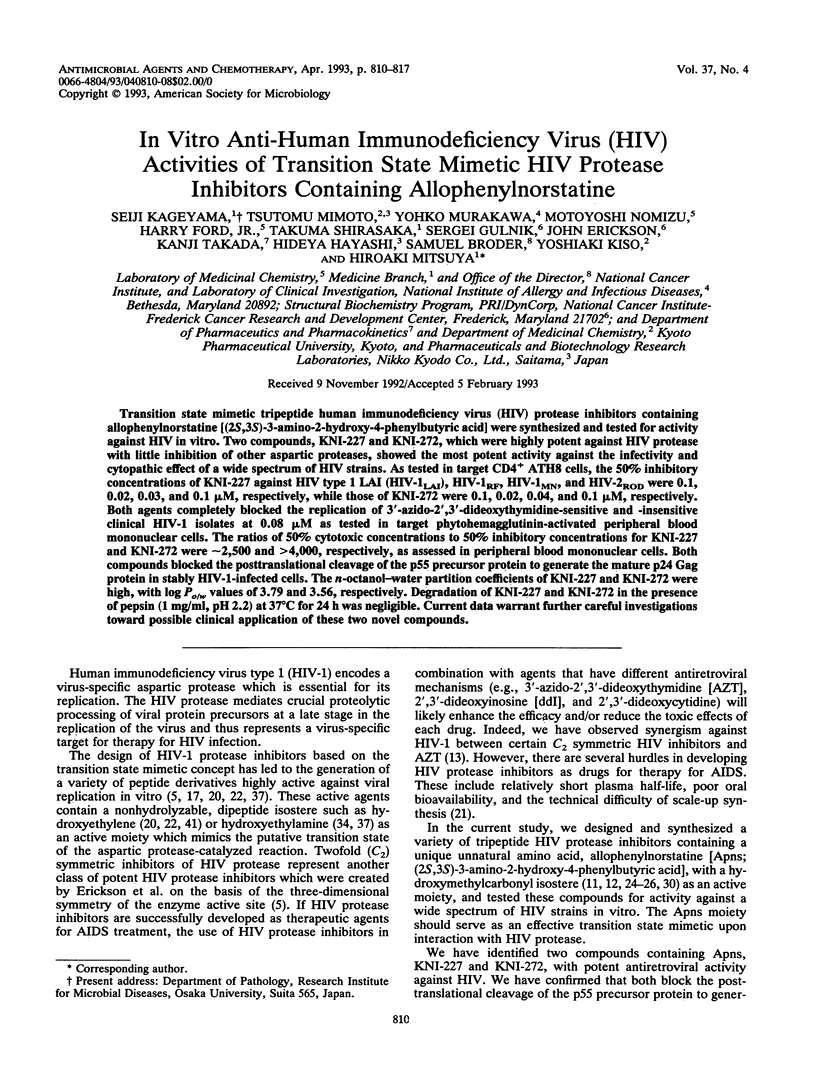
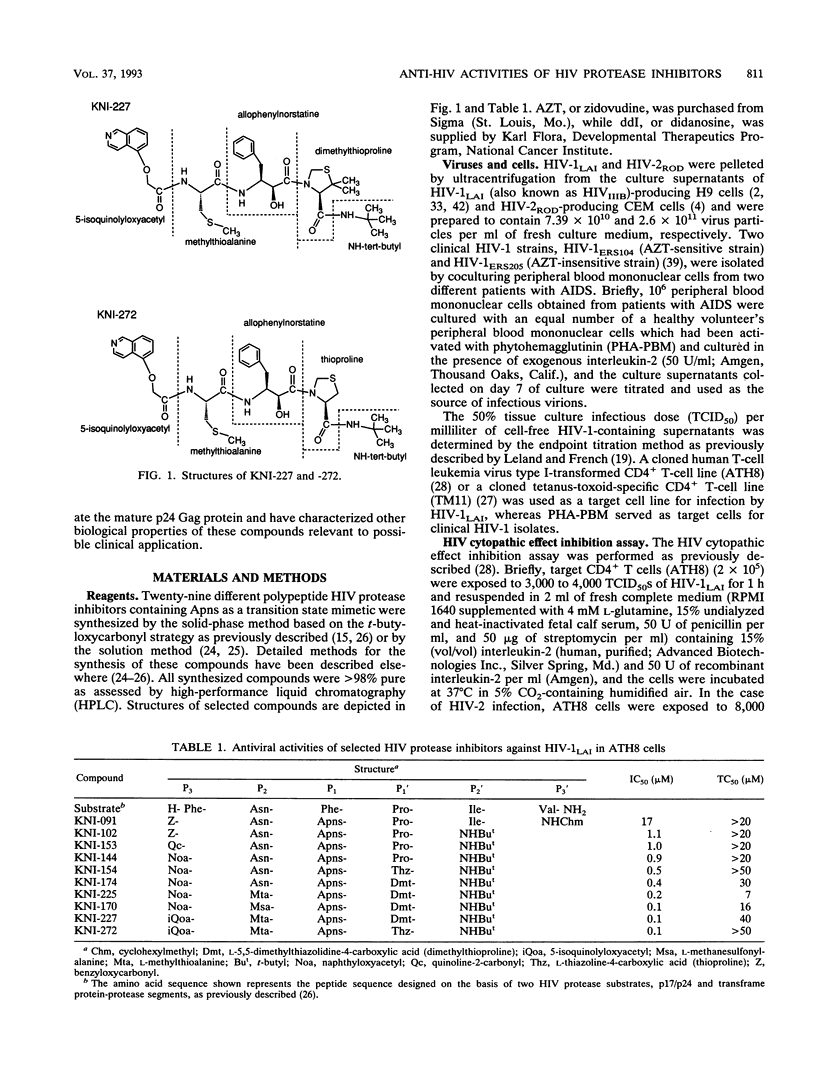
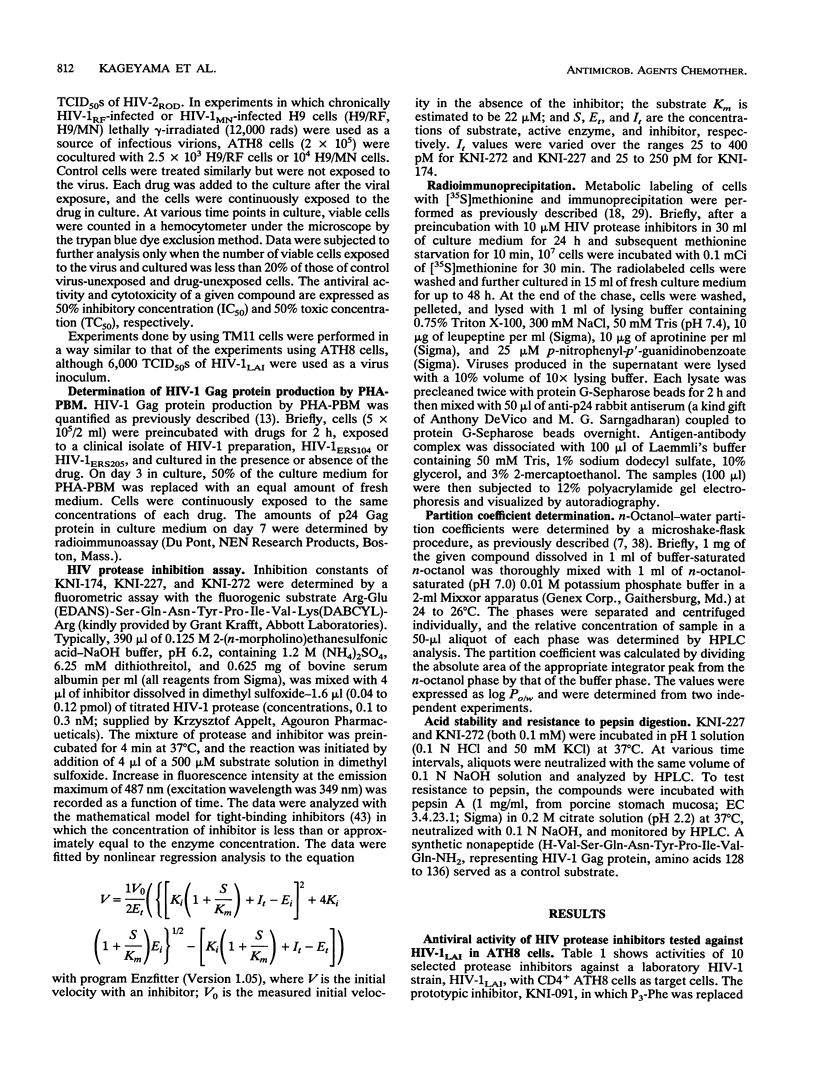
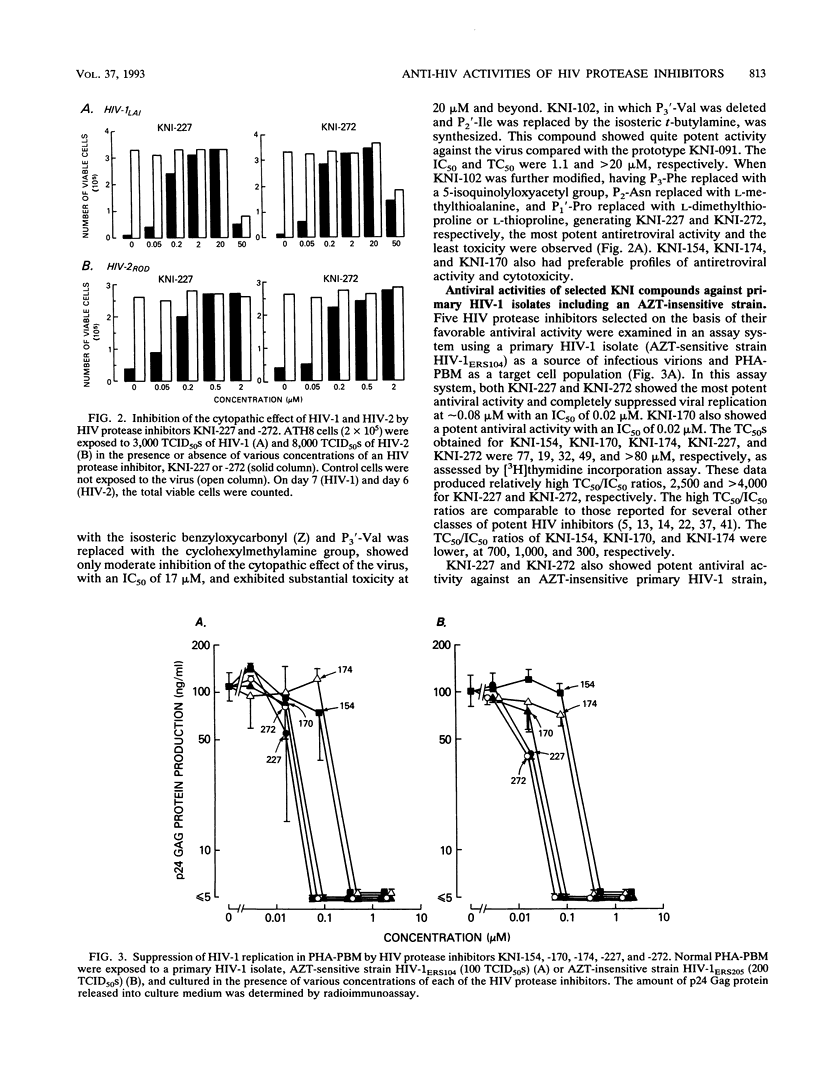
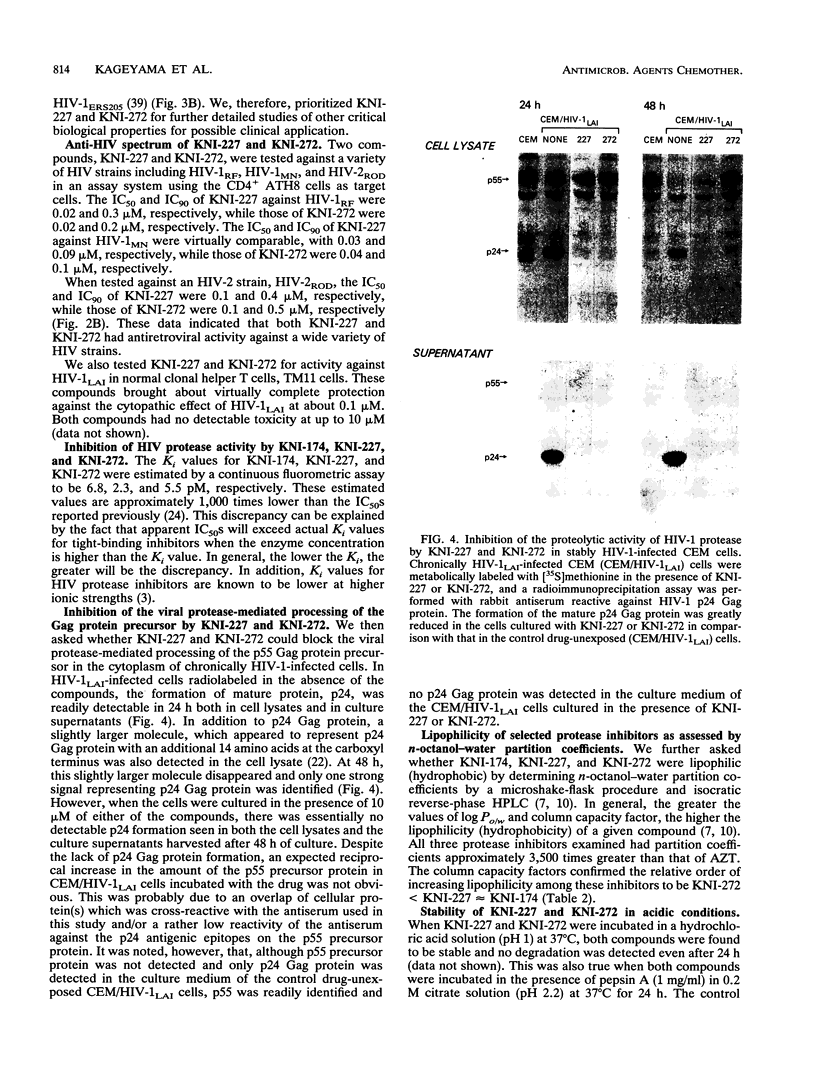
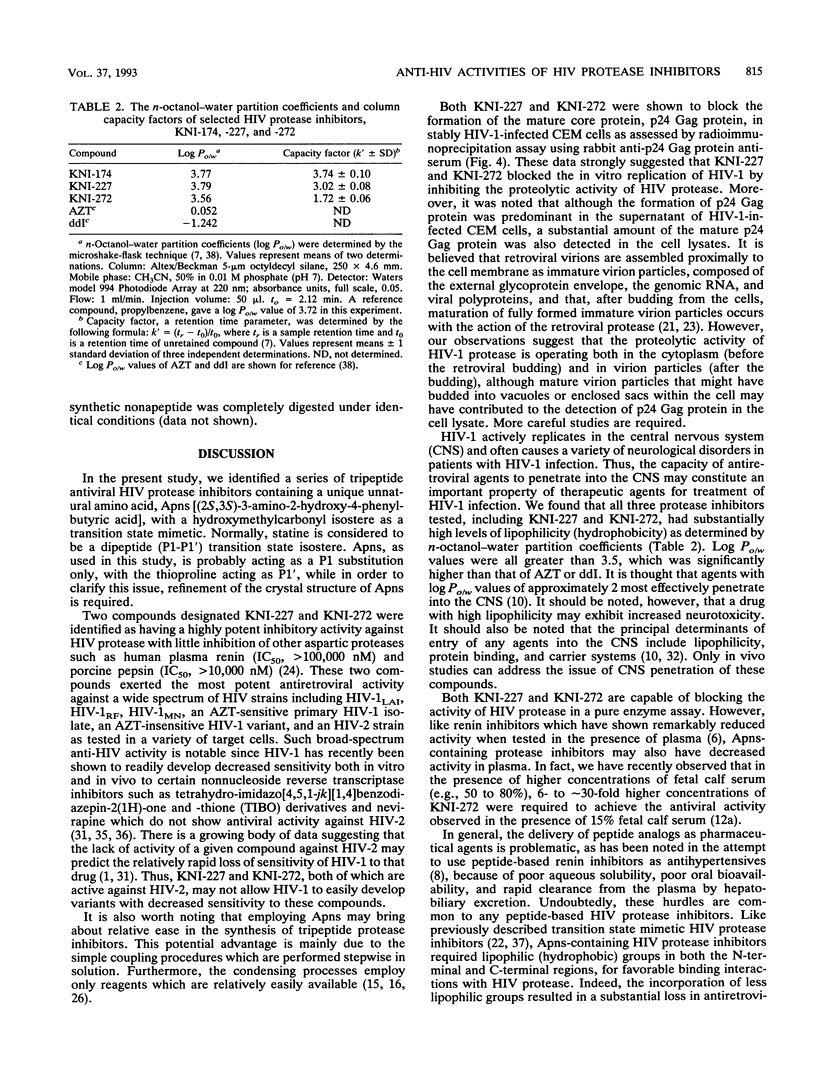
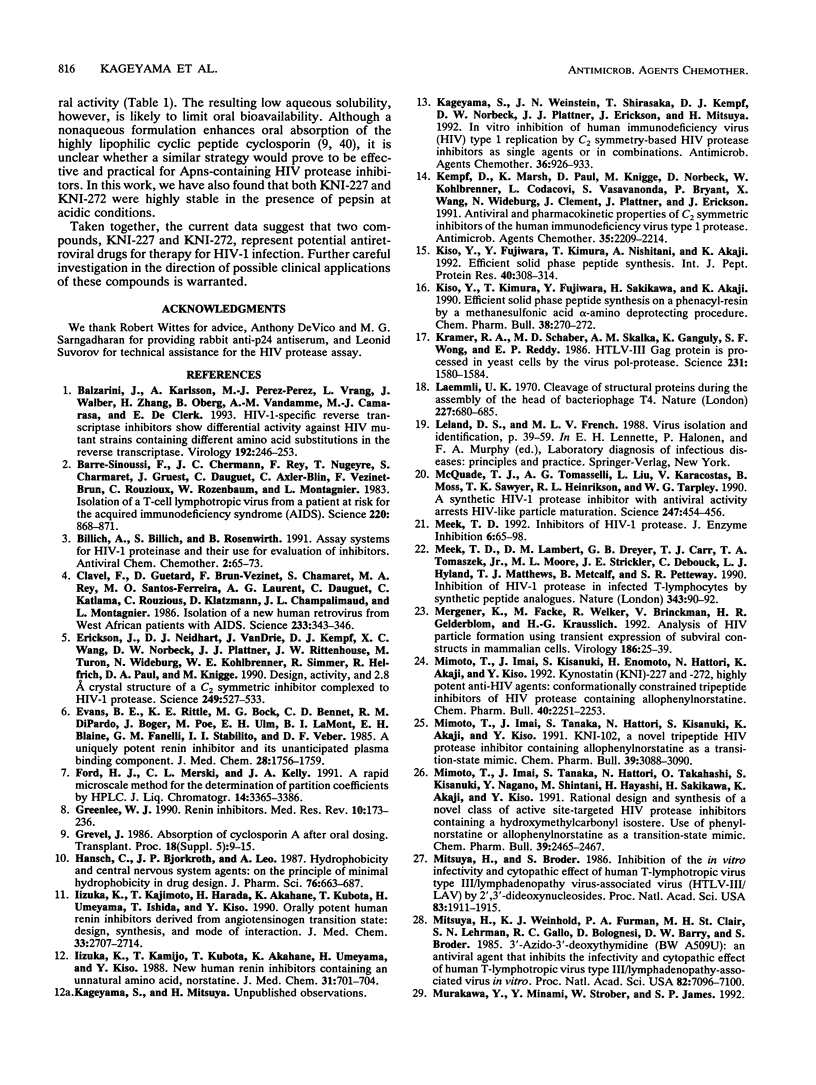
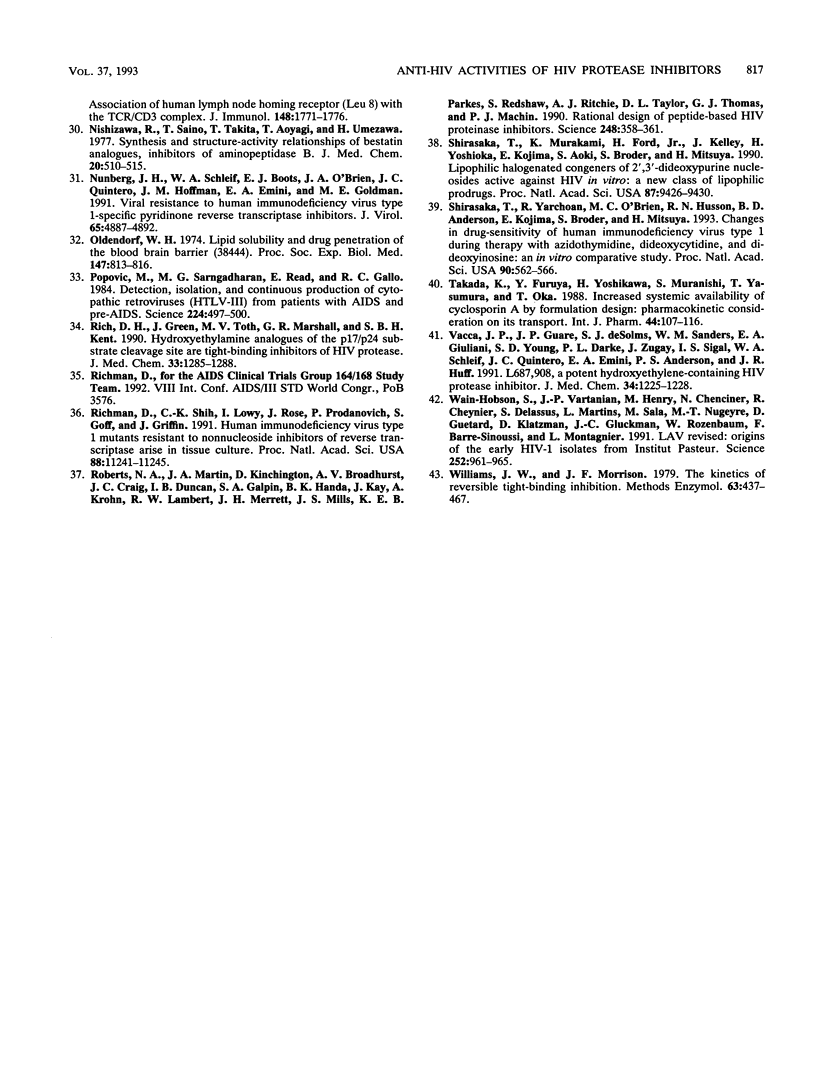
Images in this article
Selected References
These references are in PubMed. This may not be the complete list of references from this article.
- Balzarini J., Karlsson A., Pérez-Pérez M. J., Vrang L., Walbers J., Zhang H., Oberg B., Vandamme A. M., Camarasa M. J., De Clercq E. HIV-1-specific reverse transcriptase inhibitors show differential activity against HIV-1 mutant strains containing different amino acid substitutions in the reverse transcriptase. Virology. 1993 Jan;192(1):246–253. doi: 10.1006/viro.1993.1027. [DOI] [PubMed] [Google Scholar]
- Barré-Sinoussi F., Chermann J. C., Rey F., Nugeyre M. T., Chamaret S., Gruest J., Dauguet C., Axler-Blin C., Vézinet-Brun F., Rouzioux C. Isolation of a T-lymphotropic retrovirus from a patient at risk for acquired immune deficiency syndrome (AIDS). Science. 1983 May 20;220(4599):868–871. doi: 10.1126/science.6189183. [DOI] [PubMed] [Google Scholar]
- Clavel F., Guétard D., Brun-Vézinet F., Chamaret S., Rey M. A., Santos-Ferreira M. O., Laurent A. G., Dauguet C., Katlama C., Rouzioux C. Isolation of a new human retrovirus from West African patients with AIDS. Science. 1986 Jul 18;233(4761):343–346. doi: 10.1126/science.2425430. [DOI] [PubMed] [Google Scholar]
- Erickson J., Neidhart D. J., VanDrie J., Kempf D. J., Wang X. C., Norbeck D. W., Plattner J. J., Rittenhouse J. W., Turon M., Wideburg N. Design, activity, and 2.8 A crystal structure of a C2 symmetric inhibitor complexed to HIV-1 protease. Science. 1990 Aug 3;249(4968):527–533. doi: 10.1126/science.2200122. [DOI] [PubMed] [Google Scholar]
- Evans B. E., Rittle K. E., Bock M. G., Bennett C. D., DiPardo R. M., Boger J., Poe M., Ulm E. H., LaMont B. I., Blaine E. H. A uniquely potent renin inhibitor and its unanticipated plasma binding component. J Med Chem. 1985 Dec;28(12):1755–1756. doi: 10.1021/jm00150a001. [DOI] [PubMed] [Google Scholar]
- Greenlee W. J. Renin inhibitors. Med Res Rev. 1990 Apr-Jun;10(2):173–236. doi: 10.1002/med.2610100203. [DOI] [PubMed] [Google Scholar]
- Grevel J. Absorption of cyclosporine A after oral dosing. Transplant Proc. 1986 Dec;18(6 Suppl 5):9–15. [PubMed] [Google Scholar]
- Hansch C., Björkroth J. P., Leo A. Hydrophobicity and central nervous system agents: on the principle of minimal hydrophobicity in drug design. J Pharm Sci. 1987 Sep;76(9):663–687. doi: 10.1002/jps.2600760902. [DOI] [PubMed] [Google Scholar]
- Iizuka K., Kamijo T., Harada H., Akahane K., Kubota T., Umeyama H., Ishida T., Kiso Y. Orally potent human renin inhibitors derived from angiotensinogen transition state: design, synthesis, and mode of interaction. J Med Chem. 1990 Oct;33(10):2707–2714. doi: 10.1021/jm00172a005. [DOI] [PubMed] [Google Scholar]
- Iizuka K., Kamijo T., Kubota T., Akahane K., Umeyama H., Kiso Y. New human renin inhibitors containing an unnatural amino acid, norstatine. J Med Chem. 1988 Apr;31(4):701–704. doi: 10.1021/jm00399a001. [DOI] [PubMed] [Google Scholar]
- Kageyama S., Weinstein J. N., Shirasaka T., Kempf D. J., Norbeck D. W., Plattner J. J., Erickson J., Mitsuya H. In vitro inhibition of human immunodeficiency virus (HIV) type 1 replication by C2 symmetry-based HIV protease inhibitors as single agents or in combinations. Antimicrob Agents Chemother. 1992 May;36(5):926–933. doi: 10.1128/aac.36.5.926. [DOI] [PMC free article] [PubMed] [Google Scholar]
- Kempf D. J., Marsh K. C., Paul D. A., Knigge M. F., Norbeck D. W., Kohlbrenner W. E., Codacovi L., Vasavanonda S., Bryant P., Wang X. C. Antiviral and pharmacokinetic properties of C2 symmetric inhibitors of the human immunodeficiency virus type 1 protease. Antimicrob Agents Chemother. 1991 Nov;35(11):2209–2214. doi: 10.1128/aac.35.11.2209. [DOI] [PMC free article] [PubMed] [Google Scholar]
- Kiso Y., Fujiwara Y., Kimura T., Nishitani A., Akaji K. Efficient solid phase peptide synthesis. Use of methanesulfonic acid alpha-amino deprotecting procedure and new coupling reagent, 2-(benzotriazol-1-yl)oxy-1,3-dimethylimidazolidinium hexafluorophosphate (BOI). Int J Pept Protein Res. 1992 Sep-Oct;40(3-4):308–314. [PubMed] [Google Scholar]
- Kramer R. A., Schaber M. D., Skalka A. M., Ganguly K., Wong-Staal F., Reddy E. P. HTLV-III gag protein is processed in yeast cells by the virus pol-protease. Science. 1986 Mar 28;231(4745):1580–1584. doi: 10.1126/science.2420008. [DOI] [PubMed] [Google Scholar]
- Laemmli U. K. Cleavage of structural proteins during the assembly of the head of bacteriophage T4. Nature. 1970 Aug 15;227(5259):680–685. doi: 10.1038/227680a0. [DOI] [PubMed] [Google Scholar]
- McQuade T. J., Tomasselli A. G., Liu L., Karacostas V., Moss B., Sawyer T. K., Heinrikson R. L., Tarpley W. G. A synthetic HIV-1 protease inhibitor with antiviral activity arrests HIV-like particle maturation. Science. 1990 Jan 26;247(4941):454–456. doi: 10.1126/science.2405486. [DOI] [PubMed] [Google Scholar]
- Meek T. D. Inhibitors of HIV-1 protease. J Enzyme Inhib. 1992;6(1):65–98. doi: 10.3109/14756369209041357. [DOI] [PubMed] [Google Scholar]
- Meek T. D., Lambert D. M., Dreyer G. B., Carr T. J., Tomaszek T. A., Jr, Moore M. L., Strickler J. E., Debouck C., Hyland L. J., Matthews T. J. Inhibition of HIV-1 protease in infected T-lymphocytes by synthetic peptide analogues. Nature. 1990 Jan 4;343(6253):90–92. doi: 10.1038/343090a0. [DOI] [PubMed] [Google Scholar]
- Mergener K., Fäcke M., Welker R., Brinkmann V., Gelderblom H. R., Kräusslich H. G. Analysis of HIV particle formation using transient expression of subviral constructs in mammalian cells. Virology. 1992 Jan;186(1):25–39. doi: 10.1016/0042-6822(92)90058-w. [DOI] [PubMed] [Google Scholar]
- Mimoto T., Imai J., Kisanuki S., Enomoto H., Hattori N., Akaji K., Kiso Y. Kynostatin (KNI)-227 and -272, highly potent anti-HIV agents: conformationally constrained tripeptide inhibitors of HIV protease containing allophenylnorstatine. Chem Pharm Bull (Tokyo) 1992 Aug;40(8):2251–2253. doi: 10.1248/cpb.40.2251. [DOI] [PubMed] [Google Scholar]
- Mimoto T., Imai J., Tanaka S., Hattori N., Kisanuki S., Akaji K., Kiso Y. KNI-102, a novel tripeptide HIV protease inhibitor containing allophenylnorstatine as a transition-state mimic. Chem Pharm Bull (Tokyo) 1991 Nov;39(11):3088–3090. doi: 10.1248/cpb.39.3088. [DOI] [PubMed] [Google Scholar]
- Mimoto T., Imai J., Tanaka S., Hattori N., Takahashi O., Kisanuki S., Nagano Y., Shintani M., Hayashi H., Sakikawa H. Rational design and synthesis of a novel class of active site-targeted HIV protease inhibitors containing a hydroxymethylcarbonyl isostere. Use of phenylnorstatine or allophenylnorstatine as a transition-state mimic. Chem Pharm Bull (Tokyo) 1991 Sep;39(9):2465–2467. doi: 10.1248/cpb.39.2465. [DOI] [PubMed] [Google Scholar]
- Mitsuya H., Broder S. Inhibition of the in vitro infectivity and cytopathic effect of human T-lymphotrophic virus type III/lymphadenopathy-associated virus (HTLV-III/LAV) by 2',3'-dideoxynucleosides. Proc Natl Acad Sci U S A. 1986 Mar;83(6):1911–1915. doi: 10.1073/pnas.83.6.1911. [DOI] [PMC free article] [PubMed] [Google Scholar]
- Mitsuya H., Weinhold K. J., Furman P. A., St Clair M. H., Lehrman S. N., Gallo R. C., Bolognesi D., Barry D. W., Broder S. 3'-Azido-3'-deoxythymidine (BW A509U): an antiviral agent that inhibits the infectivity and cytopathic effect of human T-lymphotropic virus type III/lymphadenopathy-associated virus in vitro. Proc Natl Acad Sci U S A. 1985 Oct;82(20):7096–7100. doi: 10.1073/pnas.82.20.7096. [DOI] [PMC free article] [PubMed] [Google Scholar]
- Murakawa Y., Minami Y., Strober W., James S. P. Association of human lymph node homing receptor (Leu 8) with the TCR/CD3 complex. J Immunol. 1992 Mar 15;148(6):1771–1776. [PubMed] [Google Scholar]
- Nishizawa R., Saino T., Takita T., Suda H., Aoyagi T. Synthesis and structure-activity relationships of bestatin analogues, inhibitors of aminopeptidase B. J Med Chem. 1977 Apr;20(4):510–515. doi: 10.1021/jm00214a010. [DOI] [PubMed] [Google Scholar]
- Nunberg J. H., Schleif W. A., Boots E. J., O'Brien J. A., Quintero J. C., Hoffman J. M., Emini E. A., Goldman M. E. Viral resistance to human immunodeficiency virus type 1-specific pyridinone reverse transcriptase inhibitors. J Virol. 1991 Sep;65(9):4887–4892. doi: 10.1128/jvi.65.9.4887-4892.1991. [DOI] [PMC free article] [PubMed] [Google Scholar]
- Oldendorf W. H. Lipid solubility and drug penetration of the blood brain barrier. Proc Soc Exp Biol Med. 1974 Dec;147(3):813–815. doi: 10.3181/00379727-147-38444. [DOI] [PubMed] [Google Scholar]
- Popovic M., Sarngadharan M. G., Read E., Gallo R. C. Detection, isolation, and continuous production of cytopathic retroviruses (HTLV-III) from patients with AIDS and pre-AIDS. Science. 1984 May 4;224(4648):497–500. doi: 10.1126/science.6200935. [DOI] [PubMed] [Google Scholar]
- Rich D. H., Green J., Toth M. V., Marshall G. R., Kent S. B. Hydroxyethylamine analogues of the p17/p24 substrate cleavage site are tight-binding inhibitors of HIV protease. J Med Chem. 1990 May;33(5):1285–1288. doi: 10.1021/jm00167a003. [DOI] [PubMed] [Google Scholar]
- Richman D., Shih C. K., Lowy I., Rose J., Prodanovich P., Goff S., Griffin J. Human immunodeficiency virus type 1 mutants resistant to nonnucleoside inhibitors of reverse transcriptase arise in tissue culture. Proc Natl Acad Sci U S A. 1991 Dec 15;88(24):11241–11245. doi: 10.1073/pnas.88.24.11241. [DOI] [PMC free article] [PubMed] [Google Scholar]
- Roberts N. A., Martin J. A., Kinchington D., Broadhurst A. V., Craig J. C., Duncan I. B., Galpin S. A., Handa B. K., Kay J., Kröhn A. Rational design of peptide-based HIV proteinase inhibitors. Science. 1990 Apr 20;248(4953):358–361. doi: 10.1126/science.2183354. [DOI] [PubMed] [Google Scholar]
- Shirasaka T., Murakami K., Ford H., Jr, Kelley J. A., Yoshioka H., Kojima E., Aoki S., Broder S., Mitsuya H. Lipophilic halogenated congeners of 2',3'-dideoxypurine nucleosides active against human immunodeficiency virus in vitro. Proc Natl Acad Sci U S A. 1990 Dec;87(23):9426–9430. doi: 10.1073/pnas.87.23.9426. [DOI] [PMC free article] [PubMed] [Google Scholar]
- Shirasaka T., Yarchoan R., O'Brien M. C., Husson R. N., Anderson B. D., Kojima E., Shimada T., Broder S., Mitsuya H. Changes in drug sensitivity of human immunodeficiency virus type 1 during therapy with azidothymidine, dideoxycytidine, and dideoxyinosine: an in vitro comparative study. Proc Natl Acad Sci U S A. 1993 Jan 15;90(2):562–566. doi: 10.1073/pnas.90.2.562. [DOI] [PMC free article] [PubMed] [Google Scholar]
- Vacca J. P., Guare J. P., deSolms S. J., Sanders W. M., Giuliani E. A., Young S. D., Darke P. L., Zugay J., Sigal I. S., Schleif W. A. L-687,908, a potent hydroxyethylene-containing HIV protease inhibitor. J Med Chem. 1991 Mar;34(3):1225–1228. doi: 10.1021/jm00107a050. [DOI] [PubMed] [Google Scholar]
- Wain-Hobson S., Vartanian J. P., Henry M., Chenciner N., Cheynier R., Delassus S., Martins L. P., Sala M., Nugeyre M. T., Guétard D. LAV revisited: origins of the early HIV-1 isolates from Institut Pasteur. Science. 1991 May 17;252(5008):961–965. doi: 10.1126/science.2035026. [DOI] [PubMed] [Google Scholar]
- Williams J. W., Morrison J. F. The kinetics of reversible tight-binding inhibition. Methods Enzymol. 1979;63:437–467. doi: 10.1016/0076-6879(79)63019-7. [DOI] [PubMed] [Google Scholar]



